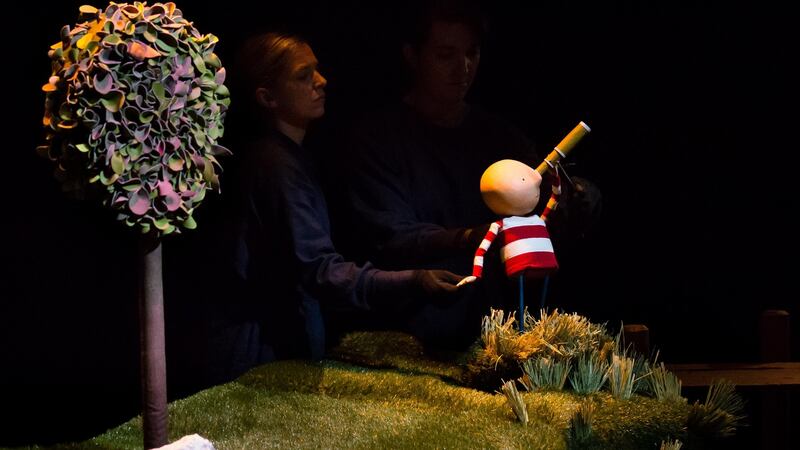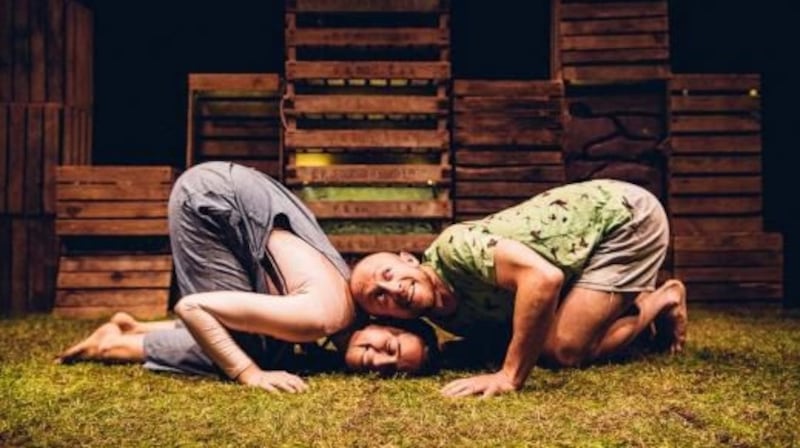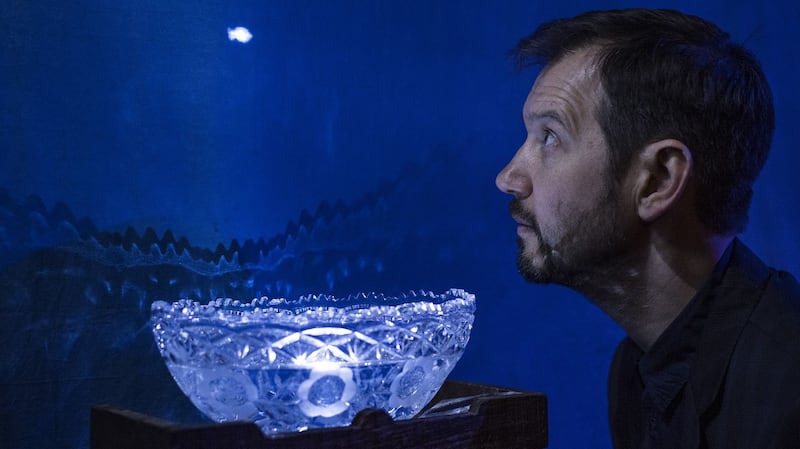For most children, the Christmas pantomime is their first experience of the theatre. The familiar fairytale storyline, the integration of pop-cultural material, the invitation to participate from the stalls, all ensure it has a broad appeal. While professional productions can be prohibitively expensive, local amateur productions, from Ballymun to Borris, provide a vital first stop for many families engaging with the performing arts for the first time.
Over the last few years, however, the breadth of theatrical experiences for children has grown considerably. It is now possible to see work from all disciplines of the performing arts for children of all ages at any time of the year. However, much of the work clusters in the months leading up to Christmas, as children return to school and artists get inspired to reach out to them. This autumn, in various venues across the country, families can participate in theatre experiences specifically designed for babies 0-12 months (the stimulating sensory show I Am Baba), an early-years opera production (Henry Purcell's The Fairy Queen is reinterpreted through a familiar daily ritual in Getting Dressed, one of the centrepieces of this year's Baboró festival), a puppet show inspired by Oliver Jeffers's popular picture-book How to Catch a Star, and dozens of other story-based shows.
It was during the investment in the cultural sector in the early years of the Celtic Tiger that children's theatre in Ireland really became serious business
Much of the work is being produced in Ireland by Irish companies, but there is no doubt that international trends have influenced both the volume and the nature of work being produced for young people in Ireland today.
The history of children's theatre in Ireland doesn't really start until the 1970s. Although there were a handful of plays written specifically for children in the early days of the Abbey (Douglas Hyde, Lady Gregory, and Máiréad Ní Ghráda all dabbled in the discipline), it wasn't until the 1970s, with the opening of the Peacock Theatre, that there was any notable professional interest in the production of work for children. This is borne out by a new research report and catalogue being launched by the Irish Theatre Institute's Irish Playography project this week, which documents the production of 247 new playscripts for young audiences since 1975. In the seven previous decades, there is a record of just five.
Young audiences
The early years of the Peacock saw writers such as Pat Ingoldsby, Eilís Dillon and Pat McCabe, among others, creating work for a young demographic on the National Theatre's smaller stage. This flurry of child-friendly activity at the Abbey was buoyed by the establishment of TEAM, which brought theatre directly into primary schools. Independent companies such as Graffiti in the mid-1980s and the Barnstorm collective in 1994 followed suit. However, it was during the investment in the cultural sector in the early years of the Celtic Tiger that children's theatre in Ireland really became serious business.
In 1995 The Ark, a cultural centre for children, opened its doors. Part of its remit was to produce new plays in its child-centred auditorium. The following year it collaborated with the Dublin Theatre Festival to showcase a trilogy of works for young audiences from international peers, a tradition which happens annually to this day. This year it welcomed an early-years dance show, Grass, from the UK, a Danish/Scottish collaboration, Night Light, and an Australian stage adaptation of Oscar Wilde's fairy-tale The Young King, which runs at The Ark until Saturday (see below).

The Baboró International Arts Festival for Children was founded in Galway in 1996 to provide a platform for professional arts practice for children, in particular performance.
These festival-based relationships, as Aideen Howard, artistic director at the Ark, observes, brought international work into domestic venues, “connecting our international colleagues with Irish audiences” and exposing artists to new influences from Europe. Baboró’s director Aislinn Ó hEocha says the international work exposed Irish artists and audiences to “a tradition where children were regarded as cultural citizens in a way that was not yet recognised in Ireland”.
This respect could be seen in the work in a formal, artistic way. “In mainland Europe,” explains Ó hEocha, “there wouldn’t be as much of a distinction between what we see as adults and children, so the work was probably a bit more abstract or challenging than an Irish audience might have expected work for children to be.” The idea that theatre for young audiences “should provoke questions, in safe way, just like all art should” was particularly inspirational.
Festival circuit
O'hEocha says that the festival context has also contributed to the development of "a whole new ecosystem of production for artists creating work for children: the festival touring circuit." Galway-based company Branar are one example of an Irish company whose work has benefited from the international relationships opened up by the festivals. Their work is now often co-produced by international partners, which the company met at Baboró, and it regularly tours to festivals as far away as China. Its latest production, How to Catch a Star, which is currently touring Ireland, opened in London's Southbank Centre earlier this year.

However, the most fundamental influence, as Ó hEocha explains, was “the fact that theatre for children was being treated with utmost seriousness. It was respected and reviewed, like any other practice, which was an empowering thing for artists interested in the area to see.”
It was also being supported in new ways by the Arts Council, on both an ideological and practical level. While funding was cut across the arts during the economic recession, the support for work for young audiences has increased in the last decade, while young audiences were singled out in the Creative Ireland strategy.
The proliferation of new companies such as Bombinate, which has two shows touring the country this autumn, and the activity of more mature companies such as Monkeyshine, whose gorgeous Magic Bookshop popped up at the Civic Theatre Tallaght on Tuesday, are testament to this ideological shift and the increased funding. But more established organisations such as the Abbey Theatre, which hosted Theatre Lovett's latest production, and Coiscéim Dance Theatre, which is in residence developing a new work at Baboró this year, have also begun to pay attention to the needs of family audiences. As have venues across the counties, many of whom host work en route to and from the Dublin Theatre Festival and Baboró.
Incredibly, much of the work the Civic Theatre provides for young audiences is free
Regional venues, such the Civic Theatre in Tallaght, have also started nurturing local work. Niamh Honer is responsible for audience development at the Civic, which this week hosts three Irish productions for young audiences. Children and families have become a key part of the theatre's programming in the last few years, Honer explains, "partly because of change in demographic in the area, but also because of increased awareness of the importance of arts provision for children as a key pillar for their development".
Increasing access
Incredibly, much of the work the Civic Theatre provides for young audiences is free. Honer explains that the theatre has done "loads of small things" to offset the cost, particularly for schools audiences, which are key to increasing access to the arts for young audiences, particularly in lower-income or socially deprived areas, where not all families can or will bring their children to the theatre. By offering development opportunities to artists such as Monkeyshine and early-years theatre pioneer Anna Newell, who have just finished year-long residencies at the theatre, they create a win-win situation for both artists and audiences.
“Work-in-progress performances allow us to provide free tickets,” Honer says, “but they also give artists real feedback about their work, making the sector overall stronger.”
Meanwhile, the Civic’s INSPIRE programme encourages the theatre’s adult audiences to make a donation towards the cost of a ticket for young person. The scheme has generated more than €10,000 since it was established at the end of 2016. As a result, this year almost 800 children will see shows at the Civic at no cost.
In a year in which one of Ireland's most significant cultural institutions for children, Lambert Puppet Theatre, closed its doors after 46 years, it is heartening to think that – at least elsewhere – artists and arts administrators around the country are working hard to ensure young audiences have access to work made especially for them.
What to see wherever you are
The Young King runs at The Ark until Sunday, as part of the Dublin Theatre Festival.
Baboró International Arts Festival takes place in Galway October 11th-19th, with performances of Night Light, The Young King, How to Catch a Star and Half-Light, among others.
I Am Baba is on national tour until December. See civictheatre.ie
Bualadh Bos Festival runs at the Lime Tree Theatre, Limerick until October 30th.
RoolaBoola takes place at the Linenhall Arts Centre in Castlebar, Co Mayo from October 13th-30th.
How to Catch a Star is on national tour until December. See branar.ie
Bombinate Theatre's Susie and the Story Shredder is at the Pavilion Theatre, Dún Laoghaire, Co Dublin on October 21st. Half-Light runs at The Ark from November 1st-3rd.

Reviews: Children’s shows at the Dublin Theatre Festival
Night Light ★★★★
The Ark, on tour
For a child, the days are measured by light: the glow of sunrise, the dim of moonshine. This production from Scottish theatre-maker Andy Manley and Danish company Teater Refleksion casts a magical spell upon the turning clock's rhythm. Manley is master of light in this 40-minute, almost wordless show, which uses miniature furniture and impeccable sound design to create an invisible world for young audience members. Manley guides his mysterious companions through their daily routines, but bedtime, of course, proves more problematic. There is a magical wonder to the execution of every little act and children will spend their own evening puzzling out the source of Manley's theatrical tricks.
Grass ★★★★
The Ark, run finished
In their interactive early-years show Grass, Second Hand Dance Company encourages us to look at the world beneath our feet. Those short green strands are a jungle for tiny creatures. The soil is a perfect sensory spot for hide and seek. Tiny inhabitants provide the inspiration for Rosie Heafford's choreography, as a pair of worms engage in a strongman battle, and another pair of ants do their friendship dance. Containers of earth are brought out at the end to allow the audience to explore the world of the play, though that's no substitute for the tantalising temptation to invade the stage that at least one young audience member couldn't resist indulging during the performance I attended.
Correction: An earlier version of this article misreported the amount of money raised by the INSPIRE programme












